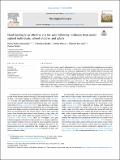Head turning is an effective cue for gaze following: Evidence from newly sighted individuals, school children and adults
Author(s)
Rubio-Fernandez, Paula; Shukla, Vishakha; Bhatia, Vrinda; Ben-Ami, Shlomit; Sinha, Pawan
DownloadPublished version (4.842Mb)
Publisher with Creative Commons License
Publisher with Creative Commons License
Creative Commons Attribution
Terms of use
Metadata
Show full item recordAbstract
In referential communication, gaze is often interpreted as a social cue that facilitates comprehension and enables word learning. Here we investigated the degree to which head turning facilitates gaze following. We presented participants with static pictures of a man looking at a target object in a first and third block of trials (pre- and post-intervention), while they saw short videos of the same man turning towards the target in the second block of trials (intervention). In Experiment 1, newly sighted individuals (treated for congenital cataracts; N = 8) benefited from the motion cues, both when comparing their initial performance with static gaze cues to their performance with dynamic head turning, and their performance with static cues before and after the videos. In Experiment 2, neurotypical school children (ages 5-10 years; N = 90) and adults (N = 30) also revealed improved performance with motion cues, although most participants had started to follow the static gaze cues before they saw the videos. Our results confirm that head turning is an effective social cue when interpreting new words, offering new insights for a pathways approach to development.
Date issued
2022Department
Massachusetts Institute of Technology. Department of Brain and Cognitive SciencesJournal
Neuropsychologia
Publisher
Elsevier BV
Citation
Rubio-Fernandez, Paula, Shukla, Vishakha, Bhatia, Vrinda, Ben-Ami, Shlomit and Sinha, Pawan. 2022. "Head turning is an effective cue for gaze following: Evidence from newly sighted individuals, school children and adults." Neuropsychologia, 174.
Version: Final published version